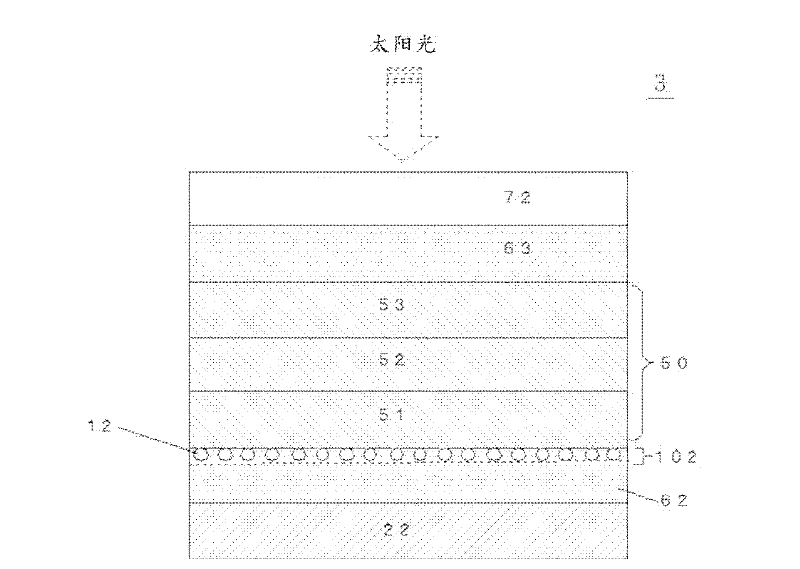Sensibilizer for solar cell and solar cell with the same
A technology of solar cells and sensitizers, applied in circuits, electrical components, photovoltaic power generation, etc., can solve the problems of lack of long-term reliability, enhancement, and diffusion, and achieve good long-term stability, improve power generation efficiency, and power generation efficiency high effect
- Summary
- Abstract
- Description
- Claims
- Application Information
AI Technical Summary
Problems solved by technology
Method used
Image
Examples
Embodiment 1
[0073] 200cm containing 5% by mass silver nanoparticles 3 The silver nanoparticle dispersion liquid was kept at 40° C., and while vigorously stirring, a 100-cm solution containing 5% by mass of tetraethoxysilane as a raw material of a transparent film was added. 3 After the ethanol solution, add 5cm 3 10% by mass of ammonia water was used as a catalyst and kept for 1 hour to obtain a dispersion containing the sensitizer of Example 1. The dispersion liquid was subjected to ultrafiltration followed by washing to obtain 7 g of the sensitizer of Example 1. The sensitizer of Example 1 produces surface plasmon resonance, and the thickness of the transparent layer is 2 nm.
Embodiment 2
[0075] In addition to adding 100cm containing 20 mass% tetraethoxysilane 3 Except the ethanol solution, it carried out similarly to Example 1, and obtained 8.5 g of the sensitizer of Example 2. The sensitizer of Example 2 produces surface plasmon resonance, and the thickness of the transparent layer is 20 nm.
Embodiment 3
[0077]Except using chloroauric acid instead of silver nitrate, it was carried out in the same manner as the production of silver nanoparticles to obtain a 100cm gold nanoparticle with an average particle diameter of 10nm containing 5% by mass. 3 gold nanoparticle dispersion.
[0078] 10cm containing 10 mass% gold nanoparticles 3 The gold nanoparticle dispersion was kept at 50°C, and while vigorously stirring, 10 cm 3 After acrylic acid as a raw material of the transparent film, 0.5 g of azobisisobutyronitrile was added as a polymerization initiator, and the dispersion liquid containing the sensitizer of Example 3 was obtained by maintaining for 1 hour. This dispersion liquid was centrifuged and the solvent was removed, and the sensitizer of Example 3 was isolated. After that, ethanol was added and stirred again in order to wash the sensitizer, the sensitizer was dispersed, and the solvent was removed by centrifugation after dispersing the sensitizer. This washing was repeat...
PUM
| Property | Measurement | Unit |
|---|---|---|
| particle size | aaaaa | aaaaa |
| thickness | aaaaa | aaaaa |
| thickness | aaaaa | aaaaa |
Abstract
Description
Claims
Application Information
 Login to View More
Login to View More - R&D
- Intellectual Property
- Life Sciences
- Materials
- Tech Scout
- Unparalleled Data Quality
- Higher Quality Content
- 60% Fewer Hallucinations
Browse by: Latest US Patents, China's latest patents, Technical Efficacy Thesaurus, Application Domain, Technology Topic, Popular Technical Reports.
© 2025 PatSnap. All rights reserved.Legal|Privacy policy|Modern Slavery Act Transparency Statement|Sitemap|About US| Contact US: help@patsnap.com



